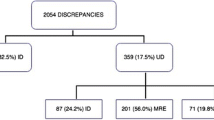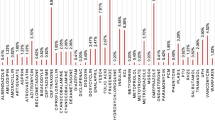Abstract
Background: Medication errors are the cause of common and dangerous adverse effects on patients. They occur as a result of preventable failures in the prescribing (ordering), transcribing, dispensing and administration of medications.
Objective: The aim of this study was to determine the relationship between patient characteristics and prescribing and transcribing medication errors during acute hospitalization of elderly patients in an internal medicine ward.
Methods: A cohort case-control study was conducted in a 37-bed medical ward at a tertiary medical centre in Israel. The study included 137 patients in whom potentially harmful medication errors were detected, and 137 sex- and age-matched controls. Clinical data were collected and Charlson Comorbidity Index scores were calculated. Conditional logistic regression was used to identify factors associated with medication errors.
Results: Independent factors associated with any type of medication error included Charlson Comorbidity Index score ≥8 (odds ratio [OR] 2.97 [95% CI 1.16, 7.61], p = 0.023), number of medications ≥9 (OR 2.02 [95% CI 1.00, 4.05], p = 0.049) [both upon admission] and length of hospital stay ≥13 days (OR 4.41 [95% CI 2.25, 8.62], p < 0.0001). Independent factors associated with prescribing errors included Charlson Comorbidity Index score ≥8 (OR 6.34 [95% CI 1.63,24.71], p = 0.008) and length of hospital stay ≥13 days (OR 3.19 [95% CI 1.23, 8.26], p = 0.017), while independent factors associated with transcribing errors included number of medications ≥9 (OR 2.58 [95% CI 1.02, 6.51], p = 0.04) and length of hospital stay ≥13 days (OR 6.90 [95% CI 2.76, 17.23], p < 0.0001). The median time to an error was 3 days, and was half as long for prescribing errors as for transcribing errors (2 and 4 days, respectively, p = 0.017).
Conclusions: The risk of medication errors among elderly patients during acute hospitalization in an internal medicine ward is associated with Charlson Comorbidity Index score (for prescribing errors), number of medications (for transcribing errors) and length of hospital stay (for both types of errors). Further study will determine whether these factors can be used to identify patients at risk and to prevent prescribing and transcribing medication errors.








Similar content being viewed by others
References
Barker KN, Flynn EA, Pepper GA, et al. Medication errors observed in 36 health care facilities. Arch Intern Med 2002; 162: 1897–903
Bobb A, Gleason K, Husch M, et al. The epidemiology of prescribing errors: the potential impact of computerized prescriber order entry. Arch Intern Med 2004; 164: 785–92
van Doormaal JE, van den Bemt PM, Mol PG, et al. Medication errors: the impact of prescribing and transcribing errors on preventable harm in hospitalised patients. Qual Saf Health Care 2009; 18: 22–7
Leape LL, Bates DW, Cullen DJ, et al. Systems analysis of adverse drug events. JAMA 1995; 274: 35–43
Leape LL, Brennan TA, Laird NM, et al. The nature of adverse events in hospitalized patients. N Engl J Med 1991; 324: 377–84
Dean B, Schachter M, Vincent C, et al. Causes of prescribing errors in hospital inpatients: a prospective study. Lancet 2002; 359: 1373–8
Lesar TS, Briceland L, Stein DS. Factors related to errors in medication prescribing. JAMA 1997; 277: 312–7
Raz T, Kraus GP. Prediction of medication error probability based on patient characteristics. Qual Assur Health Care 1989; 1: 207–16
Field TS, Gurwitz JH, Avorn J, et al. Risk factors for adverse drug events among nursing home residents. Arch Intern Med 2001; 161: 1629–34
Bates DW, Miller EB, Cullen DJ, et al. Patient risk factors for adverse drug events in hospitalized patients. ADE Prevention Study Group. Arch Intern Med 1999; 159: 2553–60
Deyo RA, Cherkin DC, Ciol MA. Adapting a clinical comorbidity index for use with ICD-9-CM administrative databases. J Clin Epidemiol 1992; 45: 613–9
Charlson ME, Pompei P, Ales KL, et al. A new method of classifying prognostic comorbidity in longitudinal studies: development and validation. J Chron Dis 1987; 40: 373–83
Minicuci N, Maggi S, Noale M, et al., VELCA Group. Predicting mortality in older patients. The VELCA Study. Aging Clin Exp Res 2003; 15: 328–35
Lesar TS, Lomaestro BM, Pohl H. Medication-prescribing errors in a teaching hospital: a 9-year experience. Arch Intern Med 1997; 157: 1569–76
Onder G, Pedone C, Landi F, et al. Adverse drug reactions as cause of hospital admissions: results from the Italian Group of Pharmacoepidemiology in the Elderly (GIFA). J Am Geriatr Soc 2002; 50: 1962–8
Zhang M, Holman CD, Price SD, et al. Comorbidity and repeat admission to hospital for adverse drug reactions in older adults: retrospective cohort study. BMJ 2009; 338: a2752
Evans RS, Lloyd JF, Stoddard GJ, et al. Risk factors for adverse drug events: a 10-year analysis. Ann Pharmacother 2005; 39: 1161–8
Steurbaut S, Leemans L, Leysen T, et al. Medication history reconciliation by clinical pharmacists in elderly inpatients admitted from home or a nursing home. Ann Pharmacother 2010; 44(10): 1596–603
Andrews LB, Stocking C, Krizek T, et al. An alternative strategy for studying adverse events in medical care. Lancet 1997; 349: 309–13
Classen DC, Pestotnik SL, Evans RS, et al. Adverse drug events in hospitalized patients. Excess length of stay, extra costs, and attributable mortality. JAMA 1997; 277: 301–6
Acknowledgements
Drs Arie Ben-Yehuda and Yitzchak Bitton contributed equally to this work.
The contribution of the clinical pharmacist (ER) was partially supported by a non-restricted joint grant by Pfizer Pharmaceuticals, Israel, the Hebrew University School of Pharmacy and the Hadassah Medical Organization in Israel. The authors’ work was independent of the funder.
The authors have no conflicts of interest that are directly relevant to the content of this study.
Author information
Authors and Affiliations
Corresponding author
Rights and permissions
About this article
Cite this article
Ben-Yehuda, A., Bitton, Y., Sharon, P. et al. Risk Factors for Prescribing and Transcribing Medication Errors among Elderly Patients during Acute Hospitalization. Drugs Aging 28, 491–500 (2011). https://doi.org/10.2165/11590610-000000000-00000
Published:
Issue Date:
DOI: https://doi.org/10.2165/11590610-000000000-00000




